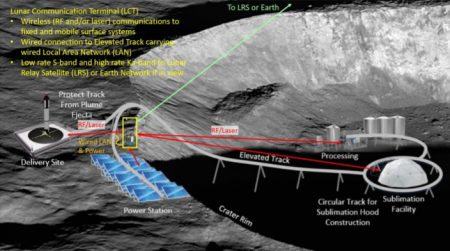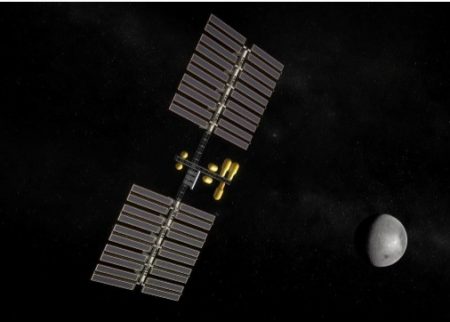November 30, 2018 – This week I had the pleasure of speaking with Dr. George Sowers, a teaching professor at the Colorado School of Mines, founder of Sowers Space Solutions, a Fellow of the American Institute of Aeronautics and Astronautics, and a believer that is humanity’s moral imperative to explore and develop space. He formed Sowers Space Solutions to make this mission statement a reality.
Dr. Sowers has worked with commercial aeronautic and space companies including the United Launch Alliance (ULA), Orbital ATK, and Blue Origin. He believes that it is companies like these that will create the space economy of the near future. And why he is teaching at the Colorado School of Mines comes into clear focus when he talks about mining the Moon, the basis upon which a self-sustaining propellant infrastructure can be built to turn space into a profitable place for business.
For Dr. Sowers, the Moon is the key because it has abundant water on or near its surface. In some areas of the lunar surface water represents 30% of the material by weight. And the way to extract it is to use solar heating. Water, when broken down, provides two very important resources: hydrogen for fuel, and oxygen to fire it up and to give humans in space breathable air. And of course, when we don’t break down water we have an essential fluid needed to sustain life and provide other benefits.
Dr. Sowers spoke to me about ISRUInfo, a space resources roundtable where a community of mining resource companies, scientists, engineers, and interested commercial companies are sharing expertise and brainstorming about the economics of a space economy. And ISRU is the key. It stands for in-situ resource utilization.
Dr. Sowers notes that space has plenty of resources so we don’t need to be delivering stuff from Earth. We have to know where to look and develop technologies for extracting and processing those resources. Water happens to be the key.
Finding it in space isn’t the same as finding it on Earth where we have access to vast amounts of the stuff in all its forms from solid, to liquid, to gas. Up until now, water has proven to be a very expensive resource in the human exploration of space. Every liter of it used on the International Space Station has to be trucked from Earth. Only recently has the ISS imported a system for recycling water from urine. A cup of coffee on the ISS today comes from water ingested and then secreted by the mission crew on board. If you can get a person to drink reprocessed water from urine that tells that water in space is an almost priceless commodity. We are talking about thousands of dollars in cost for every liter sent from Earth.
A collaborative study at the ISRUInfo site goes by the name “Commercial Lunar Propellant Architecture,” a deceptive name for what essentially is a paper that describes how to harvest and process lunar ice as a foundation for a lunar, cislunar (the area between the Earth and the Moon) and low-Earth orbit economy. Turning that ice into hydrogen for fuel, oxygen for combustion and breathable air, and using it for radiation shielding in cislunar space and beyond is the first step to a self-sufficient space economy.
To mine the water of the Moon, the study introduces a unique extraction process, using sublimation. By heating the ice in the Moon’s regolith, lunar miners can convert it directly into water vapor that would then be collected and transported to a lunar processing facility where electrolysis would break it into its constituent elements. The study suggests that the power needed for such an operation would equal 2.8 megawatts (2.0 for electrical requirements, and 0.8 for heating). To produce the energy the lunar operation could use solar energy from solar mirrors and photovoltaic panels, or a modular nuclear reactor transported from Earth. For the latter, something like the U-Battery, which I have written about in the past, could fill the bill for operations on the lunar surface particularly for mining operations where solar energy delivery might be problematic. Once the lunar ice has been processed the lunar facility would require storage tanks to collect the products produced. Launch facilities from the surface would allow the operation to ship hydrogen, oxygen, and liquid water to spacecraft in cislunar space at a fraction of the cost if brought from Earth.

What would the operation cost?
An initial investment of $4 billion US, equal to “the cost of a luxury hotel in Las Vegas,” would allow for the completion of the facility which would then kickstart a sustainable space economy based on the lower cost of fuel. The operation would continuously supply its products to waystations located in lunar orbit or at Lagrange points where spacecraft would rendezvous and fill up at the pumps. One can imagine a string of these waystations (see image below) stretching from cislunar space to Mars and beyond.

Will the lunar operation require a human presence?
The current architecture proposed in the study is designed to not need people on site. All phases of the project from construction to extraction, refining, storage, and transfer will be done by robots. You can imagine extensive use of 3D printers using lunar regolith as the material involved in constructing almost all of the infrastructure. Only the robots will come from Earth or from manufacturing and assembly facilities in low-Earth orbit.
So how much money will be saved by this $4 billion investment?
Today a kilogram of propellant costs $4,000 to low-Earth orbit, $16,000 to geosynchronous-Earth orbit where most of our communication satellites reside, and $36,000 to the lunar surface. If the same propellant came from the Moon, the cost even to low-Earth orbit would be 25% less. While the propellant in a satellite in geosynchronous-Earth orbit would save $14,500 per kilogram. And on the Moon surface itself, the cost of propellant would be $500 per kilogram, a $35,500 saving.
Dr. Sowers believes that the reemergence of interest by NASA in getting back to the Moon will realize the dream of a cislunar fueling infrastructure within the next 10 years with semi-permanent human habitation on the lunar surface to follow.
When we talked about Mars, he argued that the Moon rather than Mars is far more likely to be the place where humans will venture in the near future. Why? Because the Moon, by current conventional propulsion systems, is three days away whereas Mars is a six-month journey. The Moon can be a place to visit. It can be a temporarily assigned workplace. Or it can become a place for retirement living in the comfort of 1/6th Earth gravity.
Mars, on the other hand, states Dr. Sowers represents a permanent severing of the umbilical cord to Earth. The Moon and cislunar-based space economy might help facilitate getting to Mars, but once there, humans and their robots will need to build a local self-sufficient space economy around that planet and its resources. The cost to kickstart such a venture would be exponentially greater than that needed for the cislunar and Moon infrastructure. And the dangers associated with a Mars venture would be far greater.
As we ended our conversation it was obvious to me that Dr. Sowers is a true space evangelist and sees its commercialization as inevitable and beneficial to all of humanity. A cislunar economy he states will “release humankind from the constraints of finite earth-bound resources and provide the ultimate solution for long-range problems like climate change.”








